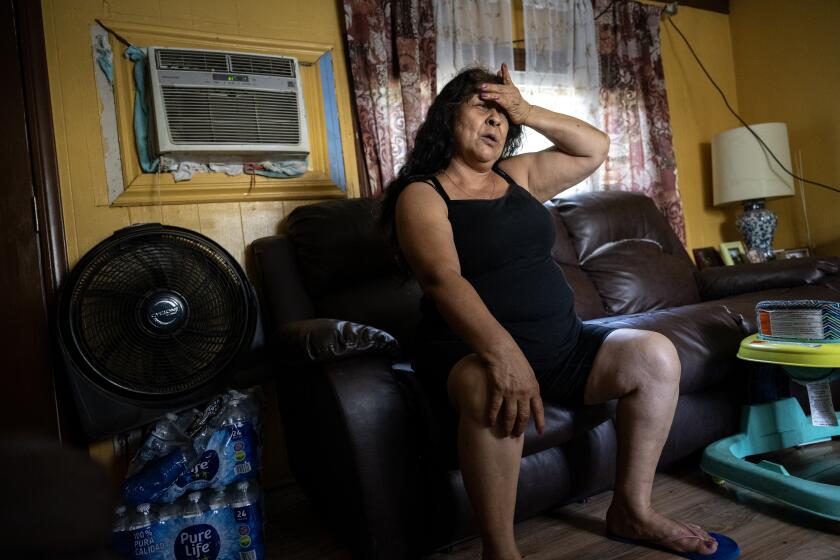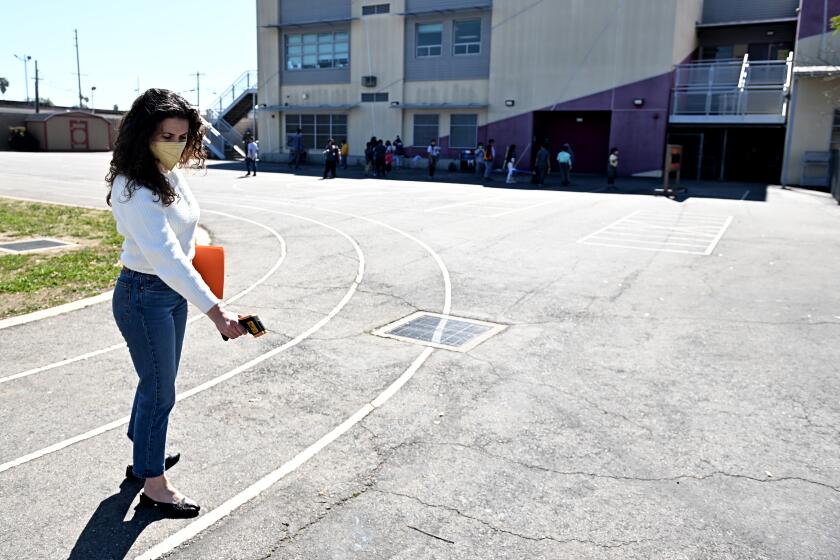Too many kids are going back to school this month without functioning A/C

- Share via
As the Los Angeles Unified School District prepares for the first day of school on Monday, it’s unclear that students will have functioning air conditioning in every classroom. Technicians have been whittling away at more than 1,000 cooling systems service calls, including about 650 classrooms with units in need of repair.
The district says that level of demand is typical for this time of year. And it’s crucial work. Having safe temperatures in classrooms should be a basic expectation, especially given that kids return to school during the worst heat of the year. But it’s not, because California doesn’t require air conditioning in K-12 classrooms, a carelessly outdated position at a time when climate change is making heat waves more dangerous and intense.
The miserable reality is that some California students are returning to classrooms this month with inadequate cooling — or no air conditioning at all. In Long Beach Unified, the state’s fourth-largest school district, thousands of students will be returning this month to 556 classrooms at 13 schools that don’t have air conditioning.
All California homes need temperature standards to prevent heat wave deaths, not just newly built ones.
How can kids be expected to concentrate, let alone achieve their best, when they are sweating, dehydrated or suffering from heat exhaustion? Sweltering classrooms are unacceptably dangerous and unfair to children, who are at increased risk of fatigue, nosebleeds, headaches, vomiting and other symptoms of heat illness because their bodies warm up faster, take longer to start sweating and have more trouble regulating temperature than adults. Hot classrooms also impede student learning, and are linked to lower test scores and academic achievement.
Long Beach Unified, in response to more than a decade of complaints about dangerously overheated classrooms, now intends to install A/C in all schools that don’t have it within the next three years. One exception is Long Beach Polytechnic High School, the district’s largest, where the whole campus won’t have A/C until 2028.
In the meantime, district officials said, classrooms without A/C will be equipped with chilled water dispensers, new or repaired window coverings and portable fans. But these are Band-Aids at best, and not much help to overheated students struggling to hear their teachers over the drone of fans that do little more than circulate hot air around like a convection oven.
It’s shameful that it has taken outcry from parents alarmed by temperatures exceeding 90 degrees inside their children’s classrooms to push some school districts to act. But fortunately for teachers, students and staff, workspace safety rules could help force schools to do more, faster.
There’s an appalling lack of standards to protect schoolchildren from extreme heat, in classrooms and on the field. California lawmakers need to change that.
New state indoor heat illness prevention rules that took effect last month require employers to use air conditioning or other cooling measures to protect workers from overheating when inside temperatures are 87 degrees or higher and to keep records of those temperatures.
The rules apply to schools and classrooms, according to the California Division of Occupational Safety and Health. But it doesn’t mean there will be automatic improvements. Enforcement usually happens in response to reports of illness or complaints from the public. Teachers and parents should not be shy about calling and emailing state regulators at the nearest district office if they think these standards are being violated in classrooms.
It’s hard to say how many schools and classrooms statewide lack air conditioning. The California Department of Education and the Division of the State Architect, which oversees the construction of K-12 schools, said they do not keep track. They should start collecting this data.
Children shouldn’t be forced to learn and play in hot, asphalt-covered, fenced-in campuses, especially in neighborhoods that already lack park space.
L.A. Unified, California’s largest district, said that all of its school campuses and classrooms have air conditioning, and San Diego Unified, the second-largest, said it has air conditioning in all schools except San Diego High School, which is using portable air conditioning units while under construction as part of a major renovation.
But even at schools with A/C, there are aging or inadequate systems that just don’t work well enough to provide a safe and comfortable environment for learning, especially when they depend on portable or window A/C units that aren’t up to the job of cooling down poorly insulated classrooms.
That’s been the case at L.A. Unified’s Bell High School, which has been the subject of past complaints about sweltering classrooms that lack working A/C. Fortunately for Bell students, just a handful of A/C repairs are needed at the moment, according to the district. A request to replace the main building’s aging system goes before the school board next year, which we hope will approve it.
Editorial: Trump and oil companies are lying to you about electric cars to serve their own interests
There is no federal ban on gas-powered cars. Trump and the oil companies are pushing that lie for their own self-serving agendas.
But school interiors aren’t the only problem. Kids don’t often find relief outside because many campuses also have inhospitably hot, parking lot-like schoolyards covered in asphalt that can heat up to 145 degrees. That calls for a holistic approach: investing in quick-turnaround projects to get adequate air conditioning inside classrooms while installing shade structures outside, planting trees and replacing heat-absorbing pavement with cooler, natural landscaping.
It’s understandable why some schools were built without air conditioning. It wasn’t considered a necessity decades ago, when average temperatures were about two degrees cooler, especially in communities closer to the coast. But global warming from our continued burning of fossil fuels has obliterated those assumptions, and state officials and school districts have been too slow to respond.
They need to catch up fast, and keep working until all kids can learn and play in an environment that’s safe from the heat.
More to Read
A cure for the common opinion
Get thought-provoking perspectives with our weekly newsletter.
You may occasionally receive promotional content from the Los Angeles Times.










